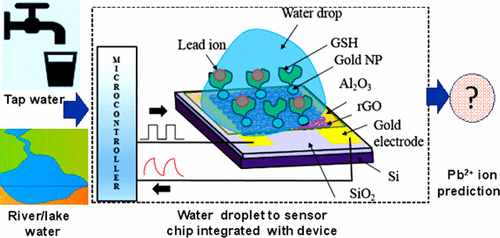Our official English website, www.x-mol.net, welcomes your feedback! (Note: you will need to create a separate account there.)
Pulse-Driven Capacitive Lead Ion Detection with Reduced Graphene Oxide Field-Effect Transistor Integrated with an Analyzing Device for Rapid Water Quality Monitoring
ACS Sensors ( IF 8.9 ) Pub Date : 2017-10-31 00:00:00 , DOI: 10.1021/acssensors.7b00496 Arnab Maity 1 , Xiaoyu Sui 1 , Chad R. Tarman 1 , Haihui Pu 1 , Jingbo Chang 1 , Guihua Zhou 1 , Ren Ren 1 , Shun Mao 2 , Junhong Chen 1
ACS Sensors ( IF 8.9 ) Pub Date : 2017-10-31 00:00:00 , DOI: 10.1021/acssensors.7b00496 Arnab Maity 1 , Xiaoyu Sui 1 , Chad R. Tarman 1 , Haihui Pu 1 , Jingbo Chang 1 , Guihua Zhou 1 , Ren Ren 1 , Shun Mao 2 , Junhong Chen 1
Affiliation

|
Rapid and real-time detection of heavy metals in water with a portable microsystem is a growing demand in the field of environmental monitoring, food safety, and future cyber-physical infrastructure. Here, we report a novel ultrasensitive pulse-driven capacitance-based lead ion sensor using self-assembled graphene oxide (GO) monolayer deposition strategy to recognize the heavy metal ions in water. The overall field-effect transistor (FET) structure consists of a thermally reduced graphene oxide (rGO) channel with a thin layer of Al2O3 passivation as a top gate combined with sputtered gold nanoparticles that link with the glutathione (GSH) probe to attract Pb2+ ions in water. Using a preprogrammed microcontroller, chemo-capacitance based detection of lead ions has been demonstrated with this FET sensor. With a rapid response (∼1–2 s) and negligible signal drift, a limit of detection (LOD) < 1 ppb and excellent selectivity (with a sensitivity to lead ions 1 order of magnitude higher than that of interfering ions) can be achieved for Pb2+ measurements. The overall assay time (∼10 s) for background water stabilization followed by lead ion testing and calculation is much shorter than common FET resistance/current measurements (∼minutes) and other conventional methods, such as optical and inductively coupled plasma methods (∼hours). An approximate linear operational range (5–20 ppb) around 15 ppb (the maximum contaminant limit by US Environmental Protection Agency (EPA) for lead in drinking water) makes it especially suitable for drinking water quality monitoring. The validity of the pulse method is confirmed by quantifying Pb2+ in various real water samples such as tap, lake, and river water with an accuracy ∼75%. This capacitance measurement strategy is promising and can be readily extended to various FET-based sensor devices for other targets.
中文翻译:

集成了分析装置的用于减少水质氧化石墨烯场效应晶体管的脉冲驱动电容式铅离子检测,可用于快速水质监测
在环境监测,食品安全和未来的网络物理基础设施领域,使用便携式微系统快速实时检测水中的重金属是一个不断增长的需求。在这里,我们报告了一种新型的超灵敏脉冲驱动的基于电容的铅离子传感器,该传感器使用自组装氧化石墨烯(GO)单层沉积策略来识别水中的重金属离子。整个场效应晶体管(FET)结构由热还原的氧化石墨烯(rGO)通道和作为顶栅的Al 2 O 3钝化薄层组成,结合溅射的金纳米颗粒,该纳米颗粒与谷胱甘肽(GSH)探针相连,吸引铅2+水中的离子。使用预编程的微控制器,该FET传感器已经证明了基于化学电容的铅离子检测。快速响应(约1-2 s)且信号漂移可忽略不计,可实现检测限(LOD)<1 ppb和出色的选择性(对铅离子的敏感性比干扰离子高1个数量级)铅2+测量。进行背景水稳定后再进行铅离子测试和计算所需的总分析时间(约10 s)比普通的FET电阻/电流测量(约数分钟)和其他常规方法(如光和电感耦合等离子体法)(约数小时)短得多)。大约15 ppb(美国环境保护署(EPA)对饮用水中铅的最大污染物限值)的大约线性工作范围(5–20 ppb)使它特别适合于饮用水质量监测。脉冲法的有效性通过对各种真实水样(如自来水,湖泊和河水中)中的Pb 2+进行定量来证实,其准确度约为75%。这种电容测量策略是有前途的,可以很容易地扩展到用于其他目标的各种基于FET的传感器设备。
更新日期:2017-10-31
中文翻译:

集成了分析装置的用于减少水质氧化石墨烯场效应晶体管的脉冲驱动电容式铅离子检测,可用于快速水质监测
在环境监测,食品安全和未来的网络物理基础设施领域,使用便携式微系统快速实时检测水中的重金属是一个不断增长的需求。在这里,我们报告了一种新型的超灵敏脉冲驱动的基于电容的铅离子传感器,该传感器使用自组装氧化石墨烯(GO)单层沉积策略来识别水中的重金属离子。整个场效应晶体管(FET)结构由热还原的氧化石墨烯(rGO)通道和作为顶栅的Al 2 O 3钝化薄层组成,结合溅射的金纳米颗粒,该纳米颗粒与谷胱甘肽(GSH)探针相连,吸引铅2+水中的离子。使用预编程的微控制器,该FET传感器已经证明了基于化学电容的铅离子检测。快速响应(约1-2 s)且信号漂移可忽略不计,可实现检测限(LOD)<1 ppb和出色的选择性(对铅离子的敏感性比干扰离子高1个数量级)铅2+测量。进行背景水稳定后再进行铅离子测试和计算所需的总分析时间(约10 s)比普通的FET电阻/电流测量(约数分钟)和其他常规方法(如光和电感耦合等离子体法)(约数小时)短得多)。大约15 ppb(美国环境保护署(EPA)对饮用水中铅的最大污染物限值)的大约线性工作范围(5–20 ppb)使它特别适合于饮用水质量监测。脉冲法的有效性通过对各种真实水样(如自来水,湖泊和河水中)中的Pb 2+进行定量来证实,其准确度约为75%。这种电容测量策略是有前途的,可以很容易地扩展到用于其他目标的各种基于FET的传感器设备。



























 京公网安备 11010802027423号
京公网安备 11010802027423号